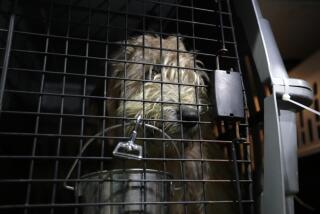Pet Overpopulation Crisis Makes Low-Cost Clinics a Necessity
Beginning Jan. 1, a new state law will require that cats and dogs being adopted from the Ventura County Department of Animal Regulation, the Humane Society or rescue groups be spayed or neutered before they are released to their new owners.
Gov. Pete Wilson and most state legislators recognize that there is a crisis of pet overpopulation in the United States. A statistic that should be more widely known is that one female and her offspring can produce as many as 67,000 dogs in six years. During a seven-year period, a female cat and her offspring can amount to 420,000 additional cats.
Every day in the United States, 40,000 puppies and kittens are born. Every year, more than 10 million cats and dogs are killed in shelters. It is of paramount importance that all animal welfare agencies make the spaying and neutering of animals their No. 1 priority.
Passage of this law was of particular interest to me because I volunteer for a Ventura County rescue organization. I work with the spay / neuter coordinator of Greyfoot Rescue to transport cats and dogs to low-cost, high-volume spay / neuter clinics outside Ventura County because these services are next to nonexistent here.
Animal Regulation in Camarillo houses many animals beyond their euthanasia date but they are so overwhelmed by the flood of incoming animals that it becomes a matter of making space. They offer no spay / neuter services and routinely adopt out unaltered cats and dogs to anyone who can pay the price, perpetuating a vicious cycle.
The cost of a dog is $70--$30 for a license and $40 for a spay / neuter deposit. How many of these paid-for procedures are actually performed is unknown, although in other localities it has been found to be fewer than half, prompting ordinances requiring spay / neuter surgeries before adoption. In meetings with elected officials, it has become clear that our director of Animal Regulation has determined that it would be impossible to perform the required surgeries, thus forcing the department to kill more animals (more than 10,000 a year).
In sharp contrast, animal control agencies in other counties have operated low-cost spay / neuter clinics for many years. In counties without clinics, innovative directors have created a network of participating veterinarians who perform affordable spay / neuter procedures.
Creative animal control directors have also used marketing techniques learned from the private sector to make their facilities more appealing, thereby increasing adoption rates. Other cost-cutting practices have been implemented, such as the use of volunteers to operate Animal Regulation’s adoption program.
The Humane Society in Ojai offers very limited low-cost spay / neuter surgeries because it employs a part-time veterinarian. Pet owners must wait three to four months for an appointment. For a rescue group such as Greyfoot, this is not workable because we acquire many animals that are in heat, pregnant, feral or prepubescent. These cases are cause for rejection for spay / neuter surgery by the Humane Society. A critical factor in successful control of the animal population is the spaying and neutering of dogs and cats younger than six months.
Dr. W.M. Mackie, owner and director of Animal Birth Control clinics in Los Angeles, is one of the pioneers of early spay / neuter operations, and has performed them since 1976. The veterinary community continues to resist embracing these advances although there is no scientific basis for the belief that spay / neuter surgery performed on animals younger than six months has any detrimental effects.
In fact, animals that undergo such procedures tend to live longer than those that don’t.
The time has come for Ventura County to catch up with other counties. We desperately need visionary directors with the ability to efficiently use available resources. They must also effectively manage day-to-day operations and possess the long-range objective of creating no-kill shelters.
All agencies must provide immediate access to spay / neuter surgeries at a minimum cost. Enlightened animal welfare organizations have learned that it is cheaper to “fix” than to kill.
More to Read
Sign up for Essential California
The most important California stories and recommendations in your inbox every morning.
You may occasionally receive promotional content from the Los Angeles Times.










